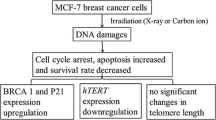Abstract
Administration of ionizing radiation for diagnostic purposes can be associated with a risk for the induction of tumors. Therefore, particularly with regard to general screening programs, e.g. with mammography, cost-benefit considerations must be discussed including risk estimation depending upon the radiation quality administered. The present study was initiated to investigate the in vitro X-ray energy dependence for the induction of chromosomal aberrations in the two mammary epithelial cell lines, 184A1 and MCF-12A. The induced excess fragments, dicentric chromosomes and centric rings were analyzed and the relative biological effectiveness (RBE) was determined for 10 and 25 kV X-rays relative to 200 kV X-rays. The assumed energy dependence with higher values for 10 kV X-rays was confirmed for the excess fragments, with RBEM values of 1.92 ± 0.26 and 1.40 ± 0.12 for 10 kV X-rays and 1.17 ± 0.12 and 0.97 ± 0.10 for 25 kV photons determined for cell lines 184A1 and MCF-12A, respectively. Meaningful results for the induction of dicentric chromosomes and centric rings were obtained only for higher doses with RBE values of 1.31 ± 0.21 and 1.70 ± 0.29 for 184A1 and 1.08 ± 0.08 and 1.43 ± 0.12 for MCF-12A irradiated with 25 and 10 kV X-rays, respectively.


Similar content being viewed by others
References
Boei JJ, Vermeulen S, Natarajan AT (1996) Detection of chromosomal aberrations by fluorescence in situ hybridization in the first three postirradiation divisions of human lymphocytes. Mutat Res 349(1):127–135
Boei JJ, Vermeulen S, Fomina J, Natarajan AT (1998) Detection of incomplete exchanges and interstitial fragments in X-irradiated human lymphocytes using a telomeric PNA probe. Int J Radiat Biol 73(6):599–603
Edwards AA, Lloyd DC, Purrott RJ (1979) Radiation induced chromosome aberrations and the Poisson distribution. Radiat Environ Biophys 16(2):89–100
Frankenberg D, Kelnhofer K, Bär K, Frankenberg-Schwager M (2002) Enhanced neoplastic transformation by mammography X rays relative to 200 kVp X rays: indication for a strong dependence on photon energy of the RBE(M) for various end points. Radiat Res 157(1):99–105 Erratum in Radiat Res 158(1):126
Göggelmann W, Jacobsen C, Panzer W, Walsh L, Roos H, Schmid E (2003) Re-evaluation of the RBE of 29 kV X-rays (mammography X-rays) relative to 220 kV X-rays using neoplastic transformation of human CGL1-hybrid cells. Radiat Environ Biophys 42(3):175–182
Hammond SL, Ham RG, Stampfer MR (1984) Serum-free growth of human mammary epithelial cells: rapid clonal growth in defined medium and extended serial passage with pituitary extract. Proc Natl Acad Sci USA 81(17):5435–5439
Heyes GJ, Mill AJ (2004) The neoplastic transformation potential of mammography X rays and atomic bomb spectrum radiation. Radiat Res 162(2):120–127
Hill MA (2004) The variation in biological effectiveness of X-rays and gamma rays with energy. Radiat Prot Dosim 112(4):471–481
ICRP (2003) ICRP Publication 92: Relative biological effectiveness (RBE), Quality Factor (Q) and Radiation Weighting Factor (wR). Annals of the ICRP 33(4). Elsevier, Oxford
Krumrey M, Ulm G, Schmid E (2004) Dicentric chromosomes in monolayers of human lymphocytes produced by monochromatized synchrotron radiation with photon energies from 1.83 keV to 17.4 keV. Radiat Environ Biophys 43(1):1–6
Lehnert A, Lessmann E, Pawelke J, Dörr W (2006) RBE of 25 kV X-rays for the survival and induction of micronuclei in the human mammary epithelial cell line MCF-12A. Radiat Environ Biophys 45(4):253–260
Lehnert A, Dörr W, Lessmann E, Pawelke J (2008) RBE of 10 kV X rays determined for the human mammary epithelial cell line MCF-12A. Radiat Res 169(3):330–336
Mestres M, Caballín MR, Barrios L, Ribas M, Barquinero JF (2008) RBE of X rays of different energies: a cytogenetic evaluation by FISH. Radiat Res 170(1):93–100
Pauley RJ, Paine TJ, Soule HD (1993) Immortal human mammary epithelial cell sublines. US Patent 5206165
Perry P, Wolff S (1974) New Giemsa method for the differential staining of sister chromatids. Nature 251(5471):156–158
Roos H, Schmid E (1998) Analysis of chromosome aberrations in human peripheral lymphocytes induced by 5.4 keV X rays. Radiat Environ Biophys 36(4):251–254
Sasaki MS, Kobayashi K, Hieda K, Yamada T, Ejima Y, Maezawa H, Furusawa Y, Ito T, Okada S (1989) Induction of chromosome aberrations in human lymphocytes by monochromatic X-rays of quantum energy between 4.8 and 14.6 keV. Int J Radiat Biol 56(6):975–988
Sasaki MS, Endo S, Ejima Y, Saito I, Okamura K, Oka Y, Hoshi M (2006) Effective dose of A-bomb radiation in Hiroshima and Nagasaki as assessed by chromosomal effectiveness of spectrum energy photons and neutrons. Radiat Environ Biophys 45(2):79–91
Schmid E, Regulla D, Kramer HM, Harder D (2002) The effect of 29 kV X rays on the dose response of chromosome aberrations in human lymphocytes. Radiat Res 158(6):771–777
Schmid E, Krumrey M, Ulm G, Roos H, Regulla D (2003) The maximum low-dose RBE of 17.4 and 40 keV monochromatic X Rays for the induction of dicentric chromosomes in human peripheral lymphocytes. Radiat Res 160(5):499–504
Słonina D, Spekl K, Panteleeva A, Brankovic K, Hoinkis C, Dörr W (2003) Induction of micronuclei in human fibroblasts and keratinocytes by 25 kV X-rays. Radiat Environ Biophys 42(1):55–61
Stampfer MR, Bartley JC (1985) Induction of transformation and continuous cell lines from normal human mammary epithelial cells after exposure to benzo[a]pyrene. Proc Natl Acad Sci USA 82(8):2394–2398
Strahlenschutzkommission des BMU (2004) Brustkrebs- und Zervixkarzinom-Screening. Berichte der Strahlenschutzkommission, Heft 42
Author information
Authors and Affiliations
Corresponding author
Rights and permissions
About this article
Cite this article
Beyreuther, E., Dörr, W., Lehnert, A. et al. Relative biological effectiveness of 25 and 10 kV X-rays for the induction of chromosomal aberrations in two human mammary epithelial cell lines. Radiat Environ Biophys 48, 333–340 (2009). https://doi.org/10.1007/s00411-009-0221-4
Received:
Accepted:
Published:
Issue Date:
DOI: https://doi.org/10.1007/s00411-009-0221-4




